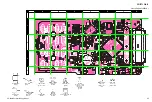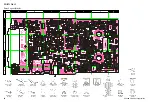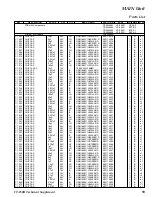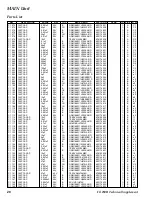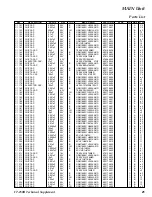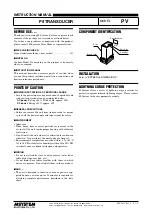
7
FT-250R Technical Supplement
Circuit Description
Receive Signal Path
Incoming RF from the antenna jack is delivered to the RF
Unit and passes through a low-pass filter and high-pass
filter consisting of coils L1001, L1002, L1003, L1004, L1014
& L1015, capacitors C1001, C1002, C1003, C1004, C1006,
C1007, C1042, C1044, C1045, C1046 & C1047, and anten-
na switching diode
D1001
(
RLS135
).
Signals within the frequency range of the transceiver are
then amplified by
Q1011
(
2SC5006
) and enter a varac-
tor-tuned band-pass filter consisting of coils L1016, L1017
& L1018, capacitors C1049, C1050, C1051, C1052, C1053,
C1054, C1056, C1057, C1058, C1059, C1060, C1061, C1062
& C1063, and diodes
D1004
,
D1005
&
D1006
(all
HVC350B
) before delivery to the first mixer,
Q1013
(
3SK296ZQ
).
Buffered output from the VCO is amplified by
Q1018
(
2SC5374
) to provide a pure first local signal between
122.3 and 126.3 MHz according to the transceiver version
and the programmed receiving frequency for injection to
the first mixer Q1013. The 21.7 MHz first mixer product
then passes through monolithic crystal filter XF1001
(21R12A4, 6 kHz BW) to strip away unwanted mixer prod-
ucts, and the IF signal is then amplified by
Q1014
(
2SC4400
).
The amplified first IF signal is applied to FM IF subsystem
IC
Q1017
(
TA31136FN
), which contains the second mix-
er, limiter amplifier, noise amplifier, and S-meter ampli-
fier.
A second local signal is generated by the reference oscil-
lator section of the PLL subsystem IC
Q1030
(
MB15A01PFV1
) using 21.25 MHz crystal X1001; a 450
kHz second IF is produced when this signal is mixed with
the first IF signal within Q1017.
The second IF then passes through the main selectivity
element, ceramic filter
CF1001
(
CFWM450E
) to strip away
all but the desired signal; it is then applied to the limiter
amplifier in Q1017, which removes amplitude variations
in the 450kHz IF, before detection of the speech by the
ceramic discriminator
CD1001
(
JTBM450CX24
).
Detected audio from Q1017 is applied to a low-pass filter
consisting of capacitors C1208, C1209 & C1210, resistors
R1320, R1321, R1322, R1323 & R1324, and
Q1060
(
NJM2902V
), then passes through the audio mute gate
Q1044
and
Q1063
(both
2SC4081
) to the buffer amplifi-
er
Q1043
(
2SC4617
); it is then passed through the de-
emphasis network consisting of capacitor C1057 and re-
sistor R1208 to a high-pass filter consisting of capacitors
C1058, C1059 & C1060, resistors R1209 & R1210, and
Q1064
(
NJM2902V
).
The processed audio passes through the another audio
mute gate
Q1041
and
Q1042
(both
2SC4081
) to the vol-
ume control potentiometer VR3001 on the VR Unit, then
is delivered to the audio amplifier
Q1053
(
DTA2822L
),
which provides up to 0.5 Watt to the headphone jack or
an 8-W loudspeaker.
Squelch Control
The squelch circuitry consists of a noise amplifier, band-
pass filter, noise detector & noise comparator within
Q1017
, audio control gate
Q1041
,
Q1042
,
Q1044
,
Q1063
(all
2SC4081
), microprocessor
Q1035
(
M3826AEFGP
),
and squelch controller S3001 on the VR Unit.
When no carrier received, noise at the output of the de-
tector stage in Q1017 is amplified and band-pass filtered
by the noise amplifier section of Q1017 and the network
between pins 7 and 8, and then rectified by the noise de-
tector section of Q1017. The resulting DC squelch control
voltage outputs at pin 13 of Q1017, then it is passed to pin
4 of the microprocessor Q1035.
If no carrier is received, this signal causes pins 44 and 47
of Q1035 to go “Low” and pin 54 to go “High.” Pin 47
disables the supply voltage to the audio amplifier
Q1053
(
TDA2822L
), and pin 54 activates the audio control gates
Q1041, Q1042, Q1044, Q1063, Q1049 and Q1050. Thus, the
microprocessor Q1035 blocks output from the audio am-
plifier, and silences the receiver, while no signal is being
received (and during transmission, as well). Meanwhile,
pin 44 signals
Q1056
(
2SC4081
) to hold the green (Busy)
half of the LED
D3001
(
BRPY1211F
) on the VR Unit off.
When a carrier appears at the discriminator, noise is re-
moved from the output, causing pin 4 of Q1035 to go “low”
and the microprocessor to activate the audio amplifier,
audio mute gate, and “Busy” LED.
The microprocessor then checks for CTCSS or CDCSS code
squelch information, if enabled, or for DTMF data on the
optional DTMF Unit. If not transmitting and CTCSS or
CDCSS is not activated, or if the received tone or code
matches that programmed, the microprocessor stops scan-
ning (if active) and allows audio to pass through the au-
dio amplifier Q1053 to the loudspeaker by enabling the
supply voltage to it via
Q1047
(
2SB1132Q
),
Q1048
(
UMW1
).
Summary of Contents for FT-250R
Page 4: ...4 FT 250R Technical Supplement Exploded View Miscellaneous Parts Note...
Page 5: ...5 Block Diagram FT 250R Technical Supplement...
Page 6: ...6 Block Diagram FT 250R Technical Supplement Note...
Page 14: ...14 FT 250R Technical Supplement Alignment Note...
Page 16: ...16 MAIN Unit FT 250R Technical Supplement...
Page 30: ...30 MAIN Unit FT 250R Technical Supplement Note...

















